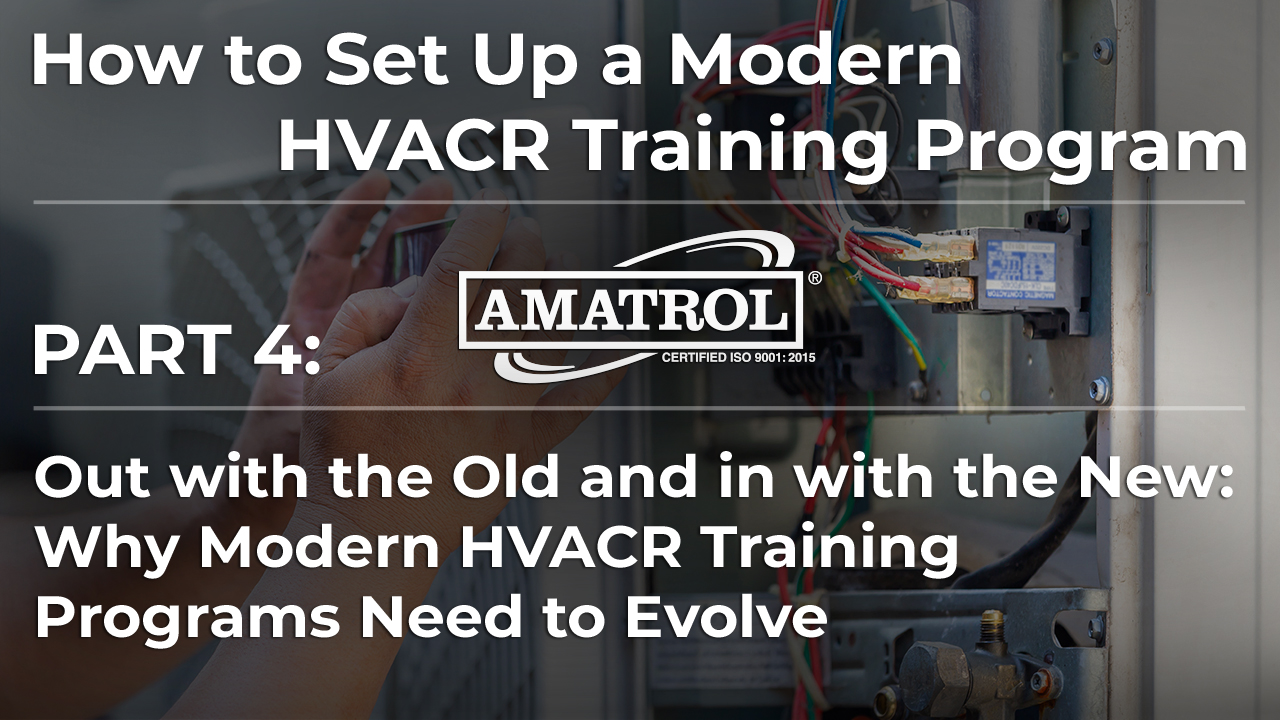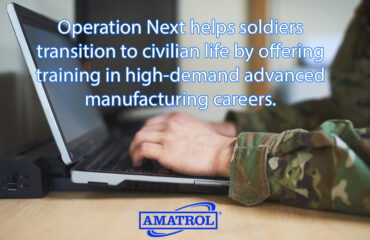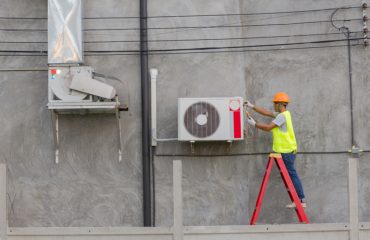*This article is part 4 of 5
In the previous article in this series, we focused on why Industry 4.0 skills are a critical part of a modern HVACR training program. With a wide range of new advanced automation technologies being used in modern HVACR systems, the HVACR technicians of today and tomorrow need advanced Industry 4.0 skills to succeed.
With the way Industry 4.0 technologies are revolutionizing industries everywhere, including HVACR, it’s a good time to reevaluate HVACR training in general. Has the way HVACR skills have been taught in the past become outdated? Are there new tools and methods that can take HVACR training to the next level?
Whether you’re updating a current HVACR training program or planning to build a new one from scratch, it’s important to take a step back and try to see the bigger picture. It’s very easy to get stuck in a rut and always do things the same way, but sometimes we need to take our focus off the trees and try to see the whole forest.
In this article, we will take a closer look at how HVACR skills have been taught in the past and highlight why it’s so important for modern HVACR training programs to evolve, including the importance of giving the next generation of HVACR technicians practical, hands-on experience with modern equipment they’ll encounter in the field.
How Have HVACR Skills been Taught in the Past?
As we’ve covered in previous articles, HVACR technicians must master a wide range of skills that span a variety of disciplines, including electrical, mechanical, print reading, etc. So how can schools and employers better prepare workers for the many HVACR technician positions available today and into the future?
Technical training is the answer. Unfortunately, not all training is created equal. The technical training for HVACR skills that has been around for many years often resembles a patchwork of pieces of courses stitched together into something instructors hope covers everything.
Teaching all the necessary skills HVACR technicians must possess to succeed requires a comprehensive approach. Future HVAC technicians need to learn troubleshooting skills using an approach that combines practical hands-on skills with theoretical knowledge. However, as instructors have learned, quality HVACR training is not a one-size-fits-all proposition.
As the Advanced Technology Institute (ATI) notes, “[p]eople learn in different ways. Some people learn by interacting with other students; some learn by getting their hands on real pieces of technology; others learn best by listening to a professor or instructor.”
According to the ATI, “[m]any people interested in a respected trade like HVAC[R] assume they can learn everything they need by just taking apart (and putting together) compressors, air handlers, heat pumps, furnaces and the like. In our age of computer-controlled devices, this is not true. Some theory is necessary.”
In addition to basic electrical and mechanical skills, HVACR technicians also need problem-solving skills that involve understanding computers, mathematics, logic, and science. For example, the ATI notes that, “[o]nce you understand things like the Ideal Gas Law and the various Laws of Thermodynamics, you can see them operate every day in cooling systems and heating plants.”
Too many HVACR training programs focus on either theoretical knowledge or hands-on skill development, but not both. As ATI concludes, “[a]n effective [HVACR] instructional strategy is to balance classroom time with hands-on lab time.”
Frequently, the hands-on skill development many students and workers receive comes in the form of working on old, broken equipment that has been donated for training purposes. In fact, many HVACR training labs resemble HVACR graveyards littered with the bones of obsolete systems. As we’ll see in the next section, relying on donations of outdated equipment to teach hands-on skills only goes so far.
Why are New Systems Vital to Modern HVACR Training?
While troubleshooting and repairing junk systems can certainly teach some important skills, these old pieces of equipment don’t come with curriculum and they don’t address the new technologies creating disruption in the HVACR world. That’s why instructors get excited when they’re fortunate enough to receive new equipment for training purposes.
Take Buckeye Career Center (BCC) in New Philadelphia, Ohio, for example. In 2018, a local company donated two heating and cooling units to BCC’s HVACR lab. Instructor Matt McGraw notes how important such systems are for training: “I’m extremely grateful. It gives them (students) the ability to work on something new. The things that were in here were older and outdated. For them to see things that are up and coming in the industry, things that they’re going to go out and see when they get jobs, it’s extremely beneficial.”
Unfortunately, not all HVACR training programs are as lucky as BCC. Nevertheless, all HVACR training programs can benefit from cleaning out the HVACR graveyard and investing in modern HVACR training systems that make high-quality training possible.
Students need hands-on experience with modern equipment with advanced technologies if they’re going to make an immediate impact in the workplace. At its core, being a skilled HVACR technician is all about problem solving. Technicians must be able to arrive on site, inspect and diagnose a system to determine what’s wrong, and then recommend the best solution for repair or replacement.
That’s why HVACR troubleshooting skills are so critical. The rusty junk systems populating the HVACR graveyards in training labs across the country can provide a limited amount of troubleshooting skill development. But why settle for limited practice with a few obsolete systems?
For those who think it’s enough just to teach the basics, it’s important to remember that, while the basics are necessary and essential building blocks, students need to be prepared to work with advanced technologies they’ll encounter on the job. HVACR companies need highly-skilled workers who can hit the ground running without extensive additional training.
Can Industry 4.0 Skills be Taught with Old Equipment?
Today, HVACR technicians must be able to install, service, troubleshoot, and repair a wide variety of different types of modern components, including furnaces, air conditioners, boilers, heat pumps, refrigerators, coolers, freezers, humidifying units, and air filtration systems, many of which will feature advanced Industry 4.0 technologies.
What does that mean for modern HVACR training programs? It means that you can’t rely upon outdated, obsolete systems to teach modern Industry 4.0 HVACR skills. If you were going to teach a modern class on electronics repair, would you fill your classroom with rotary phones and VHS VCRs? Of course not!
New HVACR technologies are becoming more and more complex. According to a recent article by Kevin Burns in The ACHR News, “many [modern] HVAC[R] systems are connected to the Internet of Things (IoT), with computers handling tasks for automatic temperature control and air quality…These days HVAC[R] technicians need more than the tools in their literal tool belt to deal with installation and maintenance — they need an education and understanding of the electronics and networks associated with modern systems.”
Burns concludes, “[t]he best HVAC[R] technicians are those who have changed with the times; bringing a solid understanding of HVAC[R] mechanics to the table, while also pursuing training opportunities to stay up-to-date with the latest trends. While current HVAC[R] technicians aren’t in danger of being replaced by robots, they may be outpaced by more tech-savvy peers if they don’t pursue continued education. Above all, HVAC[R] technicians must be flexible and willing to learn in order to keep up with the fast-paced industry.”
Building Your Modern HVACR Training Program
In this article, we’ve looked at how HVACR skills have been taught in the past and highlighted why it’s so important for modern HVACR training programs to evolve, including the importance of giving the next generation of HVACR technicians practical, hands-on experience with modern equipment they’ll encounter in the field.
In the next and final article in this series, we’ll provide a framework for building a modern HVACR training program. While it might seem like a daunting task, we’ll explain why it’s not necessary to recreate the wheel. With a trusted partner like Amatrol, starting or upgrading a modern HVACR training program is within the reach of any school or business. We’ll also take a closer look at Amatrol’s HVACR training systems, eLearning curriculum, and virtual trainers.
About Duane Bolin
Duane Bolin is a former curriculum developer and education specialist. He is currently a Marketing Content Developer in the technical training solutions market.





